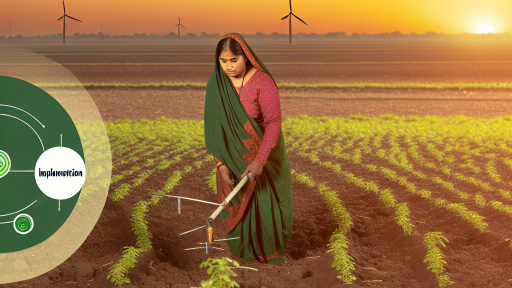Introduction
Solar energy has revolutionized the way we perceive farming.
The concept of solar farms is the focus of this blog section. Solar farms are ushering in a new era in agriculture.
Solar energy has brought about a significant change in the agricultural landscape.
Farmers are now utilizing the sun’s power to generate electricity for their farms.
This shift towards renewable energy sources has numerous benefits for both the environment and farmers.
The concept of solar farms involves the installation of solar panels on a large scale, typically on open land.
These panels absorb sunlight and convert it into usable energy.
This energy can then be used to power farm equipment, irrigation systems, and even entire farm operations.
Solar farms have several advantages. Firstly, they provide a clean and sustainable source of energy.
By utilizing the power of the sun, farmers can reduce their reliance on fossil fuels, resulting in lower carbon emissions and a smaller carbon footprint.
Furthermore, solar farms offer financial benefits to farmers.
They can save money on electricity bills by generating their own energy.
Excess energy can also be sold back to the grid, providing an additional source of income.
Moreover, in some regions, governments offer incentives and tax breaks to farmers who invest in solar energy.
Solar farms are also beneficial for the environment.
They help to reduce air and water pollution, as solar energy production does not release harmful pollutants or greenhouse gases.
Additionally, solar farms can enhance biodiversity by creating new habitats for plants and wildlife.
In fact, solar farms are revolutionizing the agricultural industry.
They provide a sustainable and clean energy source, financial benefits to farmers, and help protect the environment.
With the increasing demand for renewable energy, solar farms will continue to play a crucial role in shaping the future of agriculture.
The Importance of Solar Farms in Agriculture
A. The need for sustainable and eco-friendly farming practices
In recent years, there has been a growing concern regarding the environmental impact of traditional farming methods.
The excessive use of chemicals, reliance on fossil fuels, and deforestation have all contributed to the degradation of our planet.
As a result, there is a pressing need to adopt more sustainable and eco-friendly farming practices that can help reduce our carbon footprint and mitigate climate change.
B.
Solar farms as a solution to reduce greenhouse gas emissions
Solar farms provide a viable solution to reduce greenhouse gas emissions in agriculture.
By harnessing the power of the sun, solar farms can generate clean and renewable energy.
Unlike fossil fuels, solar energy does not release harmful carbon dioxide or other greenhouse gases into the atmosphere during production.
This has a significant positive impact on the environment and contributes to the fight against climate change.
C.
Role of solar farms in creating energy independence for farms.
Another crucial aspect of solar farms in agriculture is their role in creating energy independence for farms.
Traditional farming methods often require a substantial amount of energy to operate machinery, pumps, and other equipment.
By installing solar panels on farmland, farmers can generate their energy, reducing reliance on the grid and fossil fuels.
This not only helps farmers save money on electricity bills but also provides them with a more reliable and sustainable energy source.
Read: Regenerative Agri: Earth’s Lifeline
Benefits of Solar Farms in Agriculture
A. Reduction in energy costs for farmers
Solar farms offer a revolutionary solution for farmers to drastically reduce their energy expenses.
By harnessing sunlight and converting it into electricity, solar farms provide a sustainable and cost-effective energy source for agricultural operations.
Traditionally, farmers relied on fossil fuels and conventional electricity to power their farms.
However, these energy sources come with high costs that can significantly impact a farmer’s budget.
Solar farms eliminate these expenses by utilizing free and abundant sunlight as their primary source of energy.
Not only do solar farms reduce the energy expenditure, but they also enable farmers to become independent energy producers.
By generating their own electricity, farmers can cut ties with utility companies and avoid the unpredictability of fluctuating energy prices.
B. Long-term financial benefits and return on investment
Investing in a solar farm is a smart financial decision for farmers.
Although the initial installation costs may seem substantial, the long-term benefits and return on investment (ROI) make it a worthwhile venture.
Transform Your Agribusiness
Unlock your farm's potential with expert advice tailored to your needs. Get actionable steps that drive real results.
Get StartedFirst and foremost, solar farms have an extended lifespan, spanning up to 25 to 30 years.
During this period, farmers can enjoy significant financial savings on their energy bills.
The money saved can be reinvested back into the farm or used for other essential purposes.
Moreover, many governments and energy providers offer attractive incentive programs and subsidies for farmers who adopt solar energy.
These programs can further reduce the upfront costs and accelerate the ROI of installing a solar farm.
Considering the long-term financial benefits and the potential for reduced energy costs, solar farms represent an excellent investment opportunity for farmers.
C. Integration of solar energy with traditional farming practices
Incorporating solar energy into traditional farming practices presents an opportunity for farmers to transition into a more sustainable and environmentally friendly approach.
By setting up solar farms on unused or underutilized land, farmers can tap into the potential of renewable energy without interrupting their primary farming activities.
Solar panels can be installed on elevated structures or mounted on the ground, ensuring that agricultural operations can continue unimpeded.
Additionally, solar farms can complement other farm activities.
For instance, farmers can use the land beneath the solar panels to grow certain shade-tolerant crops or raise free-range livestock.
This integration promotes resource optimization and diversification of income streams.
D. Increased overall farm efficiency and productivity
Solar farms contribute to improved overall farm efficiency and productivity by providing consistent and reliable power supply to agricultural operations.
With a stable energy source, farmers can optimize the usage of their machinery and equipment, ensuring they operate at peak performance.
Irrigation systems, grain dryers, and animal husbandry facilities can all be powered by solar energy, reducing reliance on external power sources.
In addition, solar farms can store excess energy generated during periods of low demand.
The stored energy can be used during peak hours or when sunlight is scarce, ensuring a continuous power supply for essential farm activities.
This energy storage capability enhances the overall resilience of the farm and minimizes productivity losses.
Furthermore, solar farms have a positive environmental impact by reducing greenhouse gas emissions.
By transitioning to clean, renewable solar energy, farmers contribute to mitigating climate change and protecting the environment for future generations.
In short, solar farms offer a multitude of benefits for agriculture.
From cost reduction and financial gains to sustainability and increased efficiency, solar farms are transforming the farming industry and paving the way for a greener and more prosperous future.
Read: Climate-Smart Crops: Future of Farming
Harnessing Solar Energy on Farms
A. Installing solar panels on farmland
Farms have long been known for their vast open spaces and abundant sunlight, making them ideal locations for harnessing solar energy.
Traditional farming practices often require large amounts of electricity, but with the installation of solar panels, farmers can generate their own power and significantly reduce their carbon footprint.
Installing solar panels on farmland offers numerous benefits.
First and foremost, it provides a clean and renewable energy source.
By utilizing the power of the sun, farmers can reduce their reliance on fossil fuels and decrease their contribution to greenhouse gas emissions.
This not only helps combat climate change but also promotes environmental sustainability.
Furthermore, solar farms can generate additional income for farmers.
They can either sell excess energy back to the grid or participate in government incentive programs that provide financial support for renewable energy production.
By taking advantage of these opportunities, farmers can diversify their income streams and improve their overall economic stability.
B. Maximizing solar energy production through optimal panel positioning
To maximize the energy production of solar farms, proper positioning of solar panels is crucial.
Various factors need to be considered to ensure optimal panel placement and efficiency.
The orientation of solar panels is vital for capturing sunlight throughout the day.
Ideally, panels should face south to receive the maximum amount of sunlight.
This positioning allows them to absorb sunlight from sunrise to sunset, maximizing electricity generation.
However, depending on the geographic location, other orientations may be more suitable.
In addition to orientation, the angle of the solar panels plays a significant role in energy production.
The tilt angle should be adjusted according to the latitude of the farm to maximize annual energy yield.
By optimizing the tilt angle, farmers can ensure that their panels receive the appropriate amount of sunlight throughout the year.
C. Considering factors like orientation, angle, and shading
Apart from orientation and angle, shading is another factor that needs careful consideration when positioning solar panels.
Trees, buildings, or other structures that cast shadows on panels can significantly reduce their energy output.
Therefore, it is crucial to select a location with minimal shading or take necessary steps to mitigate shading effects.
Technology advancements, such as solar tracking systems, can also enhance energy production.
These systems allow solar panels to adjust their position throughout the day to follow the sun’s movement.
By continuously tracking the sun’s path, solar panels can maintain an optimal angle and maximize energy capture.
D. Types of solar panel systems suitable for farm setups
When it comes to solar panel systems for farms, there are various options to choose from.
The most common types include rooftop systems, ground-mounted systems, and solar canopies.
Rooftop systems are installed on existing farm buildings, utilizing available space without any additional land requirements.
They are a convenient option for farmers who want to utilize their existing infrastructure efficiently.
Ground-mounted systems, on the other hand, are directly installed on the land.
They require additional space but offer more flexibility in terms of scalability and positioning.
Farmers can choose the optimal location and orientation for maximum solar exposure.
Solar canopies provide a dual purpose by shading livestock or crops while generating solar energy.
They are particularly suitable for grazing areas or crop fields, where shading can have additional benefits apart from energy production.
Showcase Your Farming Business
Publish your professional farming services profile on our blog for a one-time fee of $200 and reach a dedicated audience of farmers and agribusiness owners.
Publish Your ProfileIn genearl, installing solar panels on farmland opens up a new era in agriculture.
With proper positioning and careful consideration of factors like orientation, angle, and shading, farmers can maximize solar energy production.
By embracing renewable energy, farmers can reduce their carbon footprint, diversify income streams, and contribute to a sustainable future.
Solar farms truly shine as a beacon of hope in the agricultural industry.
Read: Preserving Soil Moisture Amidst Drought

Challenges and Solutions for Solar Farms in Agriculture
A. Initial costs and financing options for farmers
- Solar farms require significant initial investment, including purchasing solar panels, inverters, and installation expenses.
- Financing options such as loans, grants, and government incentives can help farmers overcome the high upfront costs.
- Collaboration with solar developers or leasing arrangements can provide farmers with access to solar energy without heavy initial expenses.
- Proper financial planning and assessment of long-term benefits can help farmers make informed decisions about investing in solar farms.
B. Dealing with seasonal variations and fluctuations in energy demand
- Solar energy production relies on sunlight, which varies throughout the year due to changing seasons and weather conditions.
- Implementing energy storage systems such as batteries can help store excess energy generated during peak times for use during low sunlight periods.
- Grid connection and net metering allow farmers to sell excess energy back to the grid during the day and draw energy during low sunlight periods.
- Smart energy management systems with real-time monitoring can help optimize energy usage and reduce reliance on the grid.
C. Maintenance and monitoring of solar panel systems
- Regular inspection and cleaning of solar panels are required to ensure optimal performance and efficiency.
- Monitoring systems can remotely track the performance of solar panels, detect any malfunctions, and facilitate timely maintenance.
- Training and educating farmers about basic maintenance tasks can help them troubleshoot minor issues and minimize downtime.
- Collaborating with experienced solar installers or service providers can ensure proper maintenance and quick resolution of complex problems.
D. Addressing concerns about land use and agricultural productivity
- Solar farms can occupy valuable agricultural land, potentially reducing the available acreage for farming purposes.
- Implementing dual-use systems, such as installing solar panels above crops or in livestock grazing areas, can optimize land utilization for both solar energy and agriculture.
- Integrated farming practices, such as agrovoltaics, enable the cultivation of shade-tolerant crops under solar panels, maximizing land productivity and economic returns.
- Engaging in community consultations and considering the long-term benefits of renewable energy can help address public concerns about land use conflicts.
In a nutshell, while there are challenges associated with incorporating solar farms into agriculture, viable solutions exist.
Farmers can explore financing options, implement energy storage systems, invest in maintenance and monitoring, and adopt dual-use systems to maximize land utilization.
With the right planning and support, solar farms have the potential to revolutionize agriculture by providing sustainable energy solutions and contributing to a greener future.
Read: Irrigation in Crisis: Climate Change and Water Use
Case Studies: Successful Implementation of Solar Farms in Agriculture
A. Real-world examples of solar farms on agricultural lands
- Solar Farm in California’s Central Valley: The Farmland Solar Project converted unused agricultural land into a successful solar farm.
- Texas Solar Farm: A vast expanse of agricultural land in Texas has been transformed into a solar farm, providing clean energy to the grid.
- Solar Agriculture Project in India: Farmers in Gujarat have integrated solar panels into their farming practices, generating electricity while growing crops.
- Australian Solar Farms: Large-scale solar farms on agricultural land in Australia have revolutionized the country’s energy production.
B. The positive outcomes and benefits experienced by farmers
- Increased Income: Farmers leasing their land for solar farms receive regular income, supplementing their agricultural earnings.
- Diversified Revenue Stream: Solar farm incomes provide stability, allowing farmers to mitigate risks associated with crop yields and market fluctuations.
- Job Creation: Solar farms create new employment opportunities for local communities, benefiting both farmers and neighboring residents.
- Enhanced Sustainability: Farmers adopt sustainable practices, reducing their reliance on conventional energy sources and promoting environmental conservation.
- Reduced Water Consumption: Solar panels provide shade, minimizing evaporation and optimizing water usage in arid agricultural regions.
C. Lessons learned and best practices for future projects
- Engaging Farmers: Collaborating with farmers from the project planning stage fosters stakeholder buy-in and ensures smooth implementation.
- Assessing Land Suitability: Conducting feasibility studies and understanding local conditions are essential for identifying suitable agricultural lands for solar farms.
- Grid Integration: Coordinating with energy grid operators and implementing sound interconnection strategies is crucial for successful integration.
- Long-Term Partnerships: Establishing long-term contracts and partnerships between solar farm developers and farmers promotes mutual benefits and project longevity.
- Adequate Infrastructure: Developing necessary infrastructure to support solar farms, such as access roads and transmission lines, ensures efficient operations.
- Community Engagement: Educating local communities about the benefits of solar farms and addressing concerns fosters acceptance and support.
In summary, real-world case studies have demonstrated the successful implementation of solar farms on agricultural lands.
Farmers have experienced positive outcomes such as increased income, diversified revenue streams, and enhanced sustainability.
Lessons learned and best practices emphasize the importance of engaging farmers, assessing land suitability, grid integration, long-term partnerships, adequate infrastructure, and community engagement for future projects.
Solar farms shine as a new era in agriculture, bridging the gap between clean energy production and sustainable farming practices.
Gain More Insights: Climate-Smart Farming: The Diversity Strategy
Conclusion
A. Recap of the advantages and impact of solar farms in agriculture
Throughout this blog section, we have explored the numerous benefits and significant impact of solar farms in agriculture.
By harnessing the power of the sun, farmers are able to reduce their dependency on fossil fuels and contribute to a greener future.
One of the key advantages of solar farms is their ability to generate clean and renewable energy.
This not only helps in reducing greenhouse gas emissions but also lowers energy costs for farmers, making their operations more efficient and economical.
Solar farms also provide an opportunity for farmers to diversify their income by selling excess energy back to the grid.
This additional revenue stream can be crucial for small-scale farmers struggling to make ends meet in a volatile agricultural market.
B. Encouraging farmers to embrace solar energy and sustainable farming practices
It is essential to encourage farmers to embrace solar energy and integrate sustainable farming practices into their operations.
Government incentives and support programs can play a significant role in facilitating this transition.
By adopting solar energy, farmers can not only save money but also contribute to reducing the carbon footprint of the agricultural sector.
Additionally, implementing sustainable farming practices such as organic farming and water conservation will further enhance the environmental benefits.
C. Closing thoughts on the bright future of solar farms in agriculture
In closing, solar farms present a new era in agriculture, fostering a sustainable and environmentally friendly approach to farming.
As the technology continues to develop and costs decrease, more and more farmers will have the opportunity to embrace solar energy.
The future of solar farms in agriculture looks bright, promising a greener and more self-sufficient agriculture industry.
By harnessing the power of the sun, we can create a harmonious relationship between food production and renewable energy generation, ensuring a sustainable future for generations to come.




